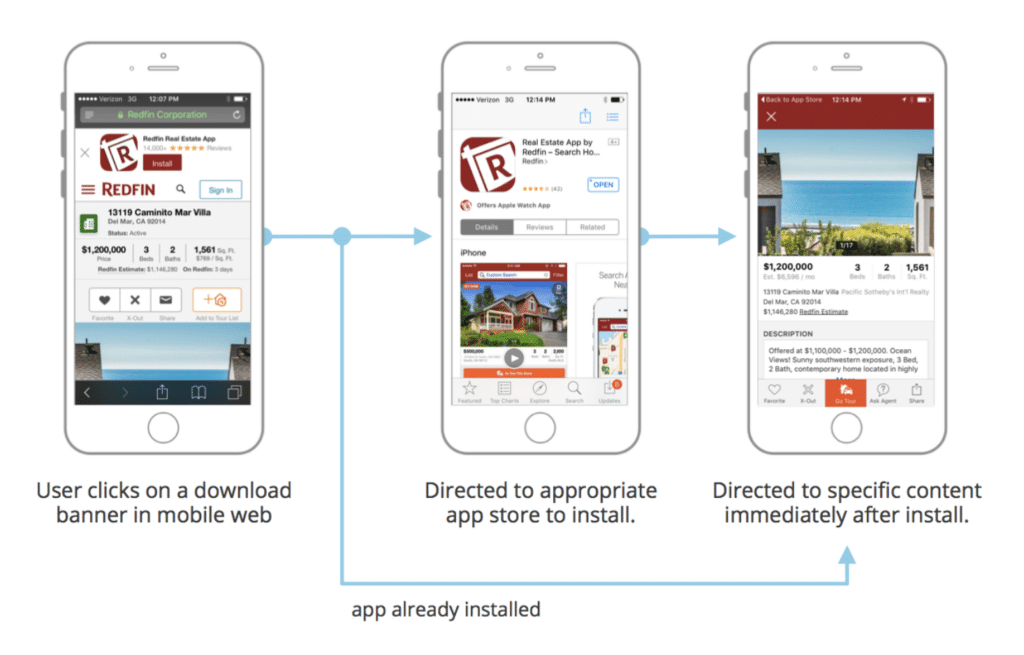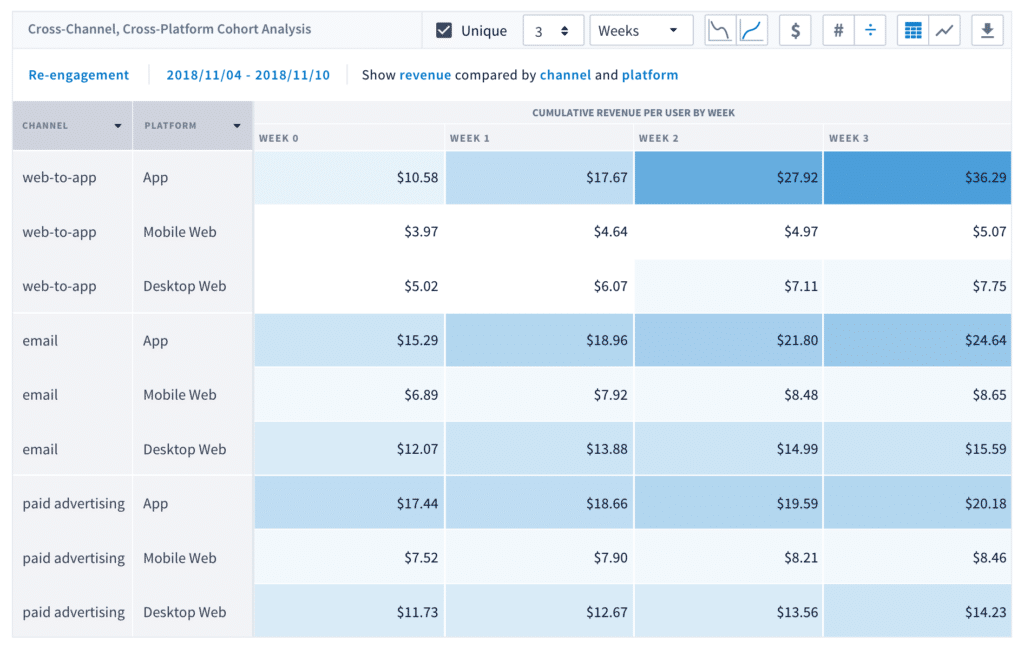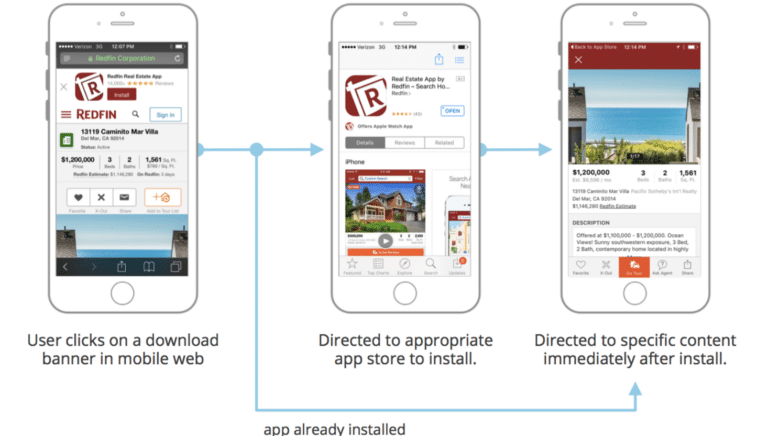Advances in attribution and deep linking have changed marketer expectations and technology stacks. Today we’ll share an update on how leading digital brands are using multi-touch attribution and deep linking to influence marketing ROI on iOS and Android. For starters: Yesterday’s definition of best no longer applies.
Point solutions are out. End-to-end is in.
Attribution and deep linking are interrelated components of the end-to-end, cross-platform analytics marketers demand.
At Branch, our attribution conversations frequently begin with a comparison between basic probabilistic modeling and attribution. Both are designed to efficiently connect brands with target audiences and drive app installs, yet one accomplishes this goal with far more precision.
Here’s how basic probabilistic modeling works and why it’s complicated:
This technology depends upon attributing click properties before and after a native app install. The main challenges with this method are the fact that OS, OS version, and device model are not universally applicable and the method primarily relies upon a user’s IP address. Plus, basic probabilistic modeling has a tendency to break on large public or corporate networks where many users may be clicking and installing simultaneously. It will also break in scenarios where users are connecting and/or disconnecting from wifi and changing their IP address. As a result, its accuracy tends to reside in the 60-70% range.
When considering what’s best for you, a basic probabilistic modeling-exclusive solution shouldn’t make the cut. This applies equally to both iOS and Android.
We introduced our attribution engine as a way to dramatically improve tracking accuracy without relying upon basic probabilistic modeling. Our technique leverages crowd-based data to build a link graph mapped to activity generated from the tremendous amount of traffic Branch sees.
Better yet, if your user flows are complicated and involve mobile web or other platforms, Branch’s attribution accurately measures those as well. To summarize, the more diverse your traffic sources and engagement points are, the more you’ll benefit from attribution based upon a comprehensive link graph rather than probabilistic modeling.
Our attribution engine was built on top of our industry-leading deep linking platform, which allows users to benefit from cross-platform deep linking capabilities and complete attribution data in a single link. In addition to providing competitive advantages, this level of efficiency is another big reason customers running iOS and Android apps trust Branch.
Now let’s talk about the importance of platform.
Cross-platform isn’t the future. It’s the here-and-now.
Users switch from screen-to-screen and platform-to-platform with the assumption that what begins on one can seamlessly continue on another (then another). Today’s deep linking for iOS and Android capitalizes on this dynamic to turn taps and clicks into installs and revenue.
We’ve covered the fundamentals of deep linking for several years and encourage you to check out other posts and resources such as our Android Deep Linking Guide (updated for 2019), and more on our deep linking solution. That said, here’s a simple illustration of how deep linking works:

What’s different about today’s deep linking solutions is the breadth of insights marketers are able to deploy in using them. An exciting new data source is Branch cohort reporting, which helps marketers identify the relationships between marketing spend and channel + platform performance. For context, here’s an example of a Branch cohort reporting screen and level of granular insights it makes available:

If you’re going to put hard-earned marketing resources to use in the fast-moving iOS and/or Android user acquisition and retention game, you’ll want to seize every available advantage. What’s best for an increasing proportion of customers are solutions that improve with scale (usage) and scope (number of complementary data points). As we’ve noted many times, market leaders combine attribution with deep linking and analytics to create a whole that’s greater than the sum of its parts.
Putting it all together: How to choose what’s best for you
Being ahead of the curve means knowing what’s required to drive mobile growth before and after install. It’s taking into account how important it is for web users to become app users who are reachable across platforms, especially when cross-platform users spend 2.2x more money than single-platform users. It’s quantifying the advantages of capturing new users via web ads rather than traditional – and often 5x more expensive – app install ads. Ultimately, it’s embracing cross-platform attribution and deep linking as a lifestyle rather than a temporary concept soon to be superseded by another new new thing. It is the new new thing (and if you’re not aboard then you’re losing customers).
As a top-line approach, you’ll want to note the composition of your installed base. If your app has more (and/or more profitable) Android users, then a solution for managing platform fragmentation and edge cases will factor into your attribution and deep linking decision. If iOS offers your business larger upside, then it’s accounting for the shortcomings of Universal Links and implementing a more comprehensive alternative. For background details in addition to the iOS and Android posts already linked, check out Deep linking: From URL and URI schemes to Universal Links, App Links, and beyond.
Three questions worth asking
As your deep linking and attribution needs evolve, here are three questions we encourage marketers and app product leaders to keep in mind:
- Are you willing to risk inaccurate attribution by using a dated solution that doesn’t account for cross-platform user touchpoints?
- Are you able to leverage accurate cross-platform attribution and industry-leading deep linking technologies using a single link?
- Are you aware of how recent advances in deep linking and analytics are influencing iOS and Android app install and engagement campaigns?
If you’re not yet working with Branch and your answer to Question 1 is No, then you should give us a call. If your answer to Question 2 is Yes, then you’re already working with Branch (thank you). And if your answer to Question 3 is either No or Not Quite, then you should also give us a call. We’d be delighted to chat.






















